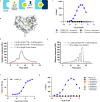A simeprevir-inducible molecular switch for the control of cell and gene therapies
- PMID: 38012128
- PMCID: PMC10682029
- DOI: 10.1038/s41467-023-43484-9
A simeprevir-inducible molecular switch for the control of cell and gene therapies
Abstract
Chemical inducer of dimerization (CID) modules can be used effectively as molecular switches to control biological processes, and thus there is significant interest within the synthetic biology community in identifying novel CID systems. To date, CID modules have been used primarily in engineering cells for in vitro applications. To broaden their utility to the clinical setting, including the potential to control cell and gene therapies, the identification of novel CID modules should consider factors such as the safety and pharmacokinetic profile of the small molecule inducer, and the orthogonality and immunogenicity of the protein components. Here we describe a CID module based on the orally available, approved, small molecule simeprevir and its target, the NS3/4A protease from hepatitis C virus. We demonstrate the utility of this CID module as a molecular switch to control biological processes such as gene expression and apoptosis in vitro, and show that the CID system can be used to rapidly induce apoptosis in tumor cells in a xenograft mouse model, leading to complete tumor regression.
© 2023. The Author(s).
Conflict of interest statement
All authors are current or former employees of AstraZeneca and may hold stocks or shares. Authors L.B., R.B.D., S.L., D.G.R., A.S., L.V., C.S., and N.J.T. are inventors on WIPO patent application WO2021009692A1. The authors declare no other competing interests.
Figures





Similar articles
-
Combinations of two drugs among NS3/4A inhibitors, NS5B inhibitors and non-selective antiviral agents are effective for hepatitis C virus with NS5A-P32 deletion in humanized-liver mice.J Gastroenterol. 2019 May;54(5):449-458. doi: 10.1007/s00535-018-01541-x. Epub 2019 Jan 25. J Gastroenterol. 2019. PMID: 30684016
-
In Vitro Activity of Simeprevir against Hepatitis C Virus Genotype 1 Clinical Isolates and Its Correlation with NS3 Sequence and Site-Directed Mutants.Antimicrob Agents Chemother. 2015 Dec;59(12):7548-57. doi: 10.1128/AAC.01444-15. Epub 2015 Sep 21. Antimicrob Agents Chemother. 2015. PMID: 26392483 Free PMC article.
-
Preclinical Characterization and Human Microdose Pharmacokinetics of ITMN-8187, a Nonmacrocyclic Inhibitor of the Hepatitis C Virus NS3 Protease.Antimicrob Agents Chemother. 2016 Dec 27;61(1):e01569-16. doi: 10.1128/AAC.01569-16. Print 2017 Jan. Antimicrob Agents Chemother. 2016. PMID: 27795376 Free PMC article.
-
[Significance of hepatitis C virus baseline polymorphism during the antiviral therapy].Orv Hetil. 2015 May 24;156(21):849-54. doi: 10.1556/650.2015.30180. Orv Hetil. 2015. PMID: 26038992 Review. Hungarian.
-
Nonstructural protein 3-4A: the Swiss army knife of hepatitis C virus.J Viral Hepat. 2011 May;18(5):305-15. doi: 10.1111/j.1365-2893.2011.01451.x. Epub 2011 Mar 23. J Viral Hepat. 2011. PMID: 21470343 Review.
Cited by
-
Novel strategies to manage CAR-T cell toxicity.Nat Rev Drug Discov. 2025 May;24(5):379-397. doi: 10.1038/s41573-024-01100-5. Epub 2025 Feb 3. Nat Rev Drug Discov. 2025. PMID: 39901030 Review.
-
Ligand-induced assembly of antibody variable fragments for the chemical regulation of biological processes.Cell Chem Biol. 2025 Mar 20;32(3):474-485.e5. doi: 10.1016/j.chembiol.2025.01.007. Epub 2025 Feb 13. Cell Chem Biol. 2025. PMID: 39952240 Free PMC article.
-
Programmable solid-state condensates for spatiotemporal control of mammalian gene expression.Nat Chem Biol. 2025 Sep;21(9):1457-1466. doi: 10.1038/s41589-025-01860-0. Epub 2025 Mar 14. Nat Chem Biol. 2025. PMID: 40087540 Free PMC article.
-
Environment signal dependent biocontainment systems for engineered organisms: Leveraging triggered responses and combinatorial systems.Synth Syst Biotechnol. 2024 Dec 20;10(2):356-364. doi: 10.1016/j.synbio.2024.12.005. eCollection 2025 Jun. Synth Syst Biotechnol. 2024. PMID: 39830078 Free PMC article. Review.
-
A trigger-inducible split-Csy4 architecture for programmable RNA modulation.Nucleic Acids Res. 2025 Jan 11;53(2):gkae1319. doi: 10.1093/nar/gkae1319. Nucleic Acids Res. 2025. PMID: 39817512 Free PMC article.
References
MeSH terms
Substances
LinkOut - more resources
Full Text Sources
Medical

